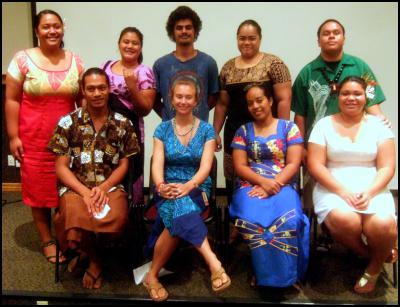ASCC Holds Third Annual Student Science Symposium
ASCC Press Release Wednesday, October 24, 2012
ASCC Holds Third Annual Student Science Symposium
By: Kelley Anderson Tagarino, ASCC Marine Science Coordinator
What do parrotfish feeding habits, coral bleaching tolerance, reef resiliency, sea turtles, aquaponics, and marine debris have to do with each other? Answer – these are all topics of research that local college students were involved in through the Marine Science Program over the past year! Seven students presented their scientific research at the American Samoa Community College (ASCC)’s third annual Student Science Symposium on Tuesday, October 23rd. The theme for this year’s symposium was “Conservation and resiliency in the face of climate change,” and while the topics were diverse they all related directly to this theme.
Research projects were supported both locally through the ASCC Marine Science Program and the Coral Reef Advisory Group (CRAG), and off-island in Hawai’i through the Undergraduate Research and Mentoring in the Biological Sciences (URM) program. ASCC’s Marine Science Program offers paid internships to interested students as a way to expose them to both the field and to scientific research.
The first presenter, Anthony Sagapolutele, discussed his research on sea turtle migration patterns based on the movements of Hawksbill and Green turtles that were satellite tagged in American Samoa. Anthony explained that satellite tags are affixed to the turtle’s carapace (top of the shell) and are programed to send their data up to satellites when the sea turtle surfaces to breathe. In this way, researchers are able to better understand where turtles go – with one Hawksbill having traveled all the way to the Pitcairn Islands, setting a long distance migration record!
Leilua Watson presented second with her research in five backreef pools around Tutuila, where she studied the strength of currents flowing over the coral and compared this to coral bleaching rates in these pools. She found that pools with higher current velocities have less coral bleaching than coral in pools with lower current velocities. This makes sense, as corals cannot get up to walk around for their food, so they rely on the ocean currents to bring it to them, and a well fed coral will be healthier and thus less likely to bleach.
Next, Rocco Tinitali presented his research from the Hawaii Institute of Marine Biology (HIMB) on Coconut Island in Kaneohe Bay on Oahu. Rocco studied the rate of bioerosion (that is, erosion caused by living organisms) on different parts of the reef around Coconut Island. Many species can contribute to bioerosion, but Parrotfish are large contributors because as they scrape algae off of coral they end up scraping off the coral skeleton too, which gets digested and excreted in the form of sand. So next time you are enjoying the nice sand, thank a Parrotfish! Rocco found that the juvenile phase of Palenose Parrotfish were responsible for more bioerosion than either of the other two Parrotfish species he studied.
The fourth presenter, Valentine Vaeoso, shared her research, also conducted at HIMB, on how two different color morphs of the same coral species can have vastly different tolerances to coral bleaching. Even though it is the same coral species, it turns out that the red colored colonies of that coral have different algae (called zooxanthellae) living in them than the orange colored colonies. As ocean temperatures continue to climb, corals will be more and more stressed, so research that can identify the more resilient corals is very important.
Meto Meredith and Judy Su’a followed with a joint presentation on their internship at ASCC’s Sea Grant, during which they helped to set up an aquaponics system. Aquaponics is a combination of hydroponics (growing plants in water without soil) and fish farming. Meto and Judy explained that the fish waste fertilizes the plants, so no additional fertilizer is needed – only fish food. Better yet, no weeding required!
Natosha Ripley, the final presenter, discussed her research with the Marine Debris Project through DMWR. Natosha explained that marine debris can come from many places such as ships, overturned trash cans, or from people who litter. Regardless of where it comes from, it all ends up in the ocean and harms our wildlife – all too often killing marine animals. Natosha implored the audience to join the Marine Debris Program and form a “trash free territory” group that pledges to keep their village clean.
The Student Science Symposium concluded with showing of a video that models what the predicted sea level rise will look like in Amouli, and shows much of the road by the village being flooded by 2090 with much of the village being underwater not long after. This video was shown as an example of how this type of tool can be used to help people visualize the impacts of climate change to their homes. It is the hope of the ASCC Marine Science Program that exposing students to research at an early stage will enable them to better deal with the realities of climate change in their future.

Click for big version.
ENDS


 WorkSafe NZ: Worker’s Six-Metre Fall Prompts Industry Call-Out
WorkSafe NZ: Worker’s Six-Metre Fall Prompts Industry Call-Out PSGR: Has MBIE Short-Circuited Good Process In Recent Government Reforms?
PSGR: Has MBIE Short-Circuited Good Process In Recent Government Reforms? The Reserve Bank of New Zealand: RBNZ’s Five Year Funding Agreement Published
The Reserve Bank of New Zealand: RBNZ’s Five Year Funding Agreement Published Lodg: Veteran Founders Disrupting Sole-Trader Accounting in NZ
Lodg: Veteran Founders Disrupting Sole-Trader Accounting in NZ New Zealand Airports Association: Airports Welcome Tourism Marketing Turbocharge
New Zealand Airports Association: Airports Welcome Tourism Marketing Turbocharge Ipsos: New Zealanders Are Still Finding It Tough Financially; Little Reprieve Expected In The Next 12 Months
Ipsos: New Zealanders Are Still Finding It Tough Financially; Little Reprieve Expected In The Next 12 Months



